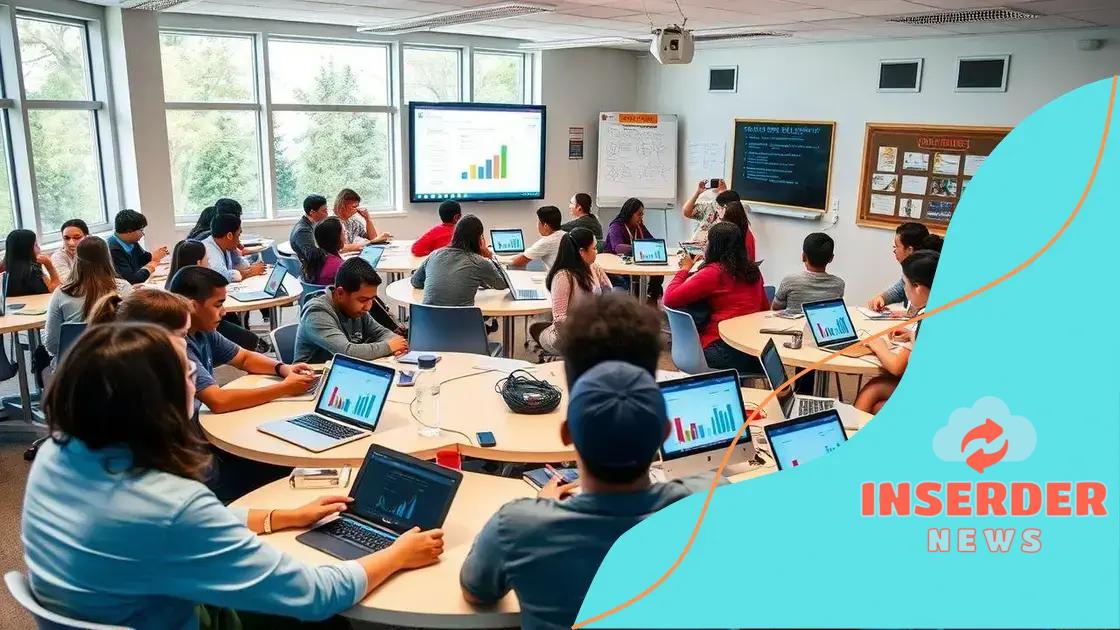The growing importance of data literacy in school curricula

The growing importance of data literacy in school curricula equips students with essential skills to analyze and interpret data, preparing them for informed decision-making in their futures.
The growing importance of data literacy in school curricula has become a hot topic in education today. Have you considered how crucial these skills are for students in a world increasingly driven by data? Let’s dive into this vital subject.
Understanding data literacy: A foundational skill
Understanding data literacy is essential for students in today’s digital age. It serves as a foundational skill that enables young learners to engage effectively with data in various aspects of their lives. From interpreting simple charts to making informed decisions based on data, the need for these skills is more pressing than ever.
Defining Data Literacy
Data literacy involves the ability to read, work with, analyze, and argue with data. This skill ensures that students can critically evaluate information and use it to support their arguments.
Key Components of Data Literacy
- Data comprehension: Understanding how to interpret data visualizations.
- Data analysis: Learning how to analyze data and identify trends.
- Data communication: Effectively presenting data findings to others.
By gaining these components, students become more adept at utilizing data for academic projects and personal interests. They can better navigate the vast sea of information available to them, making smarter choices grounded in evidence.
Data literacy also fosters critical thinking. As students analyze different data sets, they learn to question sources and understand the context behind the numbers. This ability to critique information is vital for responsible citizenship in a data-driven society.
Real-Life Applications
The skills built through data literacy extend beyond the classroom. Students will face data in their everyday lives, especially as they enter the workforce. Understanding data can help them in various careers, from marketing to healthcare, where data-driven decisions are commonplace.
Furthermore, data literacy prepares students to participate in discussions about critical topics like climate change, public health, and economics. These discussions rely on a solid grasp of data to inform opinions and policies. By focusing on data literacy in school curricula, educators equip students with an indispensable tool for success.
Integrating data literacy across subjects
Integrating data literacy across subjects is crucial for providing students with a well-rounded education. It allows them to apply their data skills in various contexts, enhancing their understanding and relevance of the material.
Cross-Disciplinary Opportunities
Data literacy can be woven into subjects like math, science, and even humanities. Each field has unique ways of using data, which can engage students deeply.
- Math: Students can analyze statistics and work with real-life data sets to solve problems.
- Science: Understanding data trends helps in experiments and interpreting results.
- Social Studies: Analyzing historical data encourages critical thinking about trends and impacts.
This cross-disciplinary approach makes data literacy relevant. Students see the importance of data in their everyday lives, motivating them to develop these essential skills.
Practical Applications in the Classroom
Teachers can introduce real-world scenarios that require data analysis. For example, students could investigate local environmental issues, collecting data on pollution or community health. By gathering and interpreting this data, students learn the impact of their findings on their community.
Moreover, technology tools like spreadsheets and data visualization software can assist students in analyzing data. Learning these tools can increase their confidence and competence in handling data tasks across subjects.
Integration not only fosters data literacy but also deepens student engagement. When they can relate their learning to real-life situations, they find the material more interesting and relevant. This makes them more likely to participate and share their insights.
Ultimately, integrating data literacy across diverse subjects cultivates critical thinkers. Students learn to approach problems analytically, utilizing data as a key component in their decision-making processes in and out of the classroom.
The role of teachers in fostering data skills

The role of teachers in fostering data skills is vital in today’s educational environment. They are the ones who guide students in understanding and utilizing data effectively, ensuring that learners develop these essential competencies.
Creating a Supportive Learning Environment
Teachers can establish a classroom culture that values data exploration. By encouraging curiosity and questioning, students will feel more comfortable engaging with data sets. This supportive atmosphere is key for students to experiment and make discoveries.
Designing Engaging Activities
Incorporating hands-on activities can help make data skills more tangible. For example, teachers can assign projects that involve collecting and analyzing real data, such as class surveys or public statistics. These activities not only teach data skills but also demonstrate the practical value of data analysis in everyday life.
- Group projects: Collaborative efforts can enhance learning and allow students to share different perspectives on data.
- Data visualization: Teachers can introduce software tools for creating graphs and charts, making data easier to understand.
- Real-world applications: Discussing current events that involve data can help students connect classroom lessons to the world around them.
Additionally, teachers can model how to interpret data. By thinking aloud and showing their reasoning, educators help students understand the processes behind data analysis. This can demystify data for students and empower them to practice these skills themselves.
Moreover, continuous professional development is important for teachers. Staying updated on new tools and methods in data literacy ensures they can effectively teach their students. Collaborating with colleagues also allows them to share strategies and resources that can enhance their teaching.
Encouraging Critical Thinking
Learning to ask the right questions about data is another crucial aspect of fostering data skills. Teachers should motivate students to evaluate the sources of their data and consider the implications of their findings. Creating assignments that prompt critical thinking about the data will further enhance their analytical skills.
The role of teachers in enhancing data skills is multifaceted. They must be guides, motivators, and model learners themselves. By promoting an engagement with data, educators prepare students not only for academic success but also for active participation in a data-driven society.
Real-world applications of data literacy
Real-world applications of data literacy are increasingly important in various fields today. Understanding how to navigate and analyze data equips individuals with skills that are valuable in the job market and everyday life.
In the Workplace
Many careers now require a solid understanding of data. For example, in marketing, professionals analyze consumer behavior using large datasets. This knowledge helps them create targeted campaigns that effectively reach their audience.
- Healthcare: Data skills are essential for tracking patient outcomes and improving care strategies.
- Finance: Financial analysts rely on data to inform investment decisions and identify trends.
- Education: Schools utilize data to assess student performance and improve curriculum.
In these scenarios, having data literacy means being able to draw insights from raw data and make informed decisions based on that analysis.
Everyday Decision-Making
Data literacy also helps individuals make better choices in everyday life. For example, when considering a new car purchase, a consumer can analyze data on fuel efficiency and long-term costs. This ability goes beyond basic calculations and involves assessing data from various sources.
Furthermore, being data literate allows people to critically evaluate the information they encounter in news articles and social media. They can discern between credible sources and misleading data, which is vital in the information age.
Community Impact
Communities benefit from data literacy through local initiatives that utilize data-driven decision-making. When analyzing crime statistics or health data, community leaders can develop targeted programs that address specific needs. This leads to better resource allocation and effective community planning.
In summary, understanding the real-world applications of data literacy empowers individuals and communities alike. With these skills, people are better equipped to navigate professional environments, make informed personal decisions, and contribute to society.
Assessment methods for data literacy
Assessment methods for data literacy are essential to ensure that students can effectively apply their skills. These assessments help educators gauge how well students understand and can work with data across various contexts.
Formative Assessments
Formative assessments are ongoing checks that inform teachers about student progress. They can take many forms, providing immediate feedback to both students and teachers.
- Quizzes: Short quizzes can assess students’ understanding of key concepts related to data analysis and interpretation.
- Class discussions: Encouraging students to discuss data findings promotes engagement and critical thinking.
- Peer assessments: Having students review each other’s work allows for collaborative learning and enhances understanding.
Using formative assessments regularly helps identify areas where students might struggle and allows for timely intervention.
Summative Assessments
Summative assessments evaluate students’ overall learning at the end of an instructional unit. These assessments can provide a comprehensive view of their data literacy skills.
- Projects: Assigning projects that require the analysis of real-world data sets challenges students to apply their learning in practical scenarios.
- Standardized tests: These can measure data literacy within a broader context, ensuring that students meet specific educational standards.
- Presentations: Having students present their findings on data analysis helps assess their ability to communicate data insights effectively.
By utilizing both formative and summative assessments, educators can create a balanced approach to evaluating data literacy. This mix not only informs instruction but also prepares students for real-world applications of their skills.
Using Technology for Assessment
Technology plays a significant role in assessing data literacy. Tools like online quizzes can provide immediate feedback, while software for data visualization allows students to showcase their analysis creatively.
Additionally, platforms that track student progress can help teachers identify trends in learning and adapt their teaching strategies accordingly. Incorporating technology ensures that assessments are engaging and relevant, reflecting the skills needed in today’s data-driven world.
FAQ – Frequently Asked Questions about Data Literacy in School Curricula
What is data literacy and why is it important?
Data literacy is the ability to read, analyze, and communicate data effectively. It is important because it helps individuals make informed decisions in both personal and professional contexts.
How can teachers assess students’ data literacy skills?
Teachers can assess data literacy through quizzes, projects, presentations, and class discussions, using both formative and summative assessment methods to gauge understanding.
What are some real-world applications of data literacy?
Real-world applications include analyzing trends in marketing, making informed financial decisions, and evaluating data in health care, education, and community planning.
How can data literacy prepare students for future careers?
Data literacy equips students with critical thinking and analytical skills that are essential in many careers, enabling them to use data to solve problems and make decisions.






